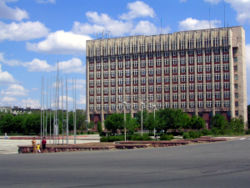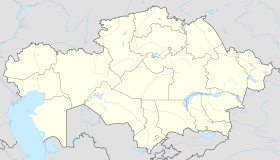Jezkazgan
|
Jezkazgan Жезқазған Жезказган |
||
|---|---|---|
 |
||
|
||
| Location in Kazakhstan | ||
| Coordinates: 47°47′0″N 67°42′0″E / 47.78333°N 67.70000°E | ||
| Country | Kazakhstan | |
| Region | Karaganda Region | |
| Founded | 1938 | |
| Government | ||
| • Akim (mayor) | Batyrlan Akhmetov | |
| Elevation | 300 m (1,000 ft) | |
| Population (2009) | ||
| • City | 86,227 | |
| • Urban | 90,661 | |
| Time zone | ALMT (UTC+6) | |
| Postal code | 100600 | |
| Area code(s) | +7 7102 | |
| Website | http://www.jezkazgan.kz | |
Jezkazgan or Zhezkazgan (Kazakh: Жезқазған / Jezqazğan/ جەزقازعان), formerly known as Dzhezkazgan (Russian: Джезказган, until 1992), is a city in Karaganda Region, Kazakhstan, on a reservoir of the Kara-Kengir River. Population: 86,227 (2009 Census results); 90,001 (1999 Census results). Its urban area includes the neighbouring mining town of Satpayev, for a total city population of 148,700.
55% of Jezkagan population are Kazakhs, 30% Russians, with smaller minorities of Ukrainians, Germans, Chechens and Koreans.
Jezkazgan is situated in the very heart of the Kazakh upland, far away from a big river. It has an extremely continental semi-arid climate (BSk); rain is frequent but never heavy and monthly rainfall has never reached 100 millimetres (4 in). The average temperature ranges from 24 °C (75 °F) in July to −16 °C (3 °F) in January, whilst extremes ranges from 43 °C (109 °F) in June 1988 to −41.1 °C (−42.0 °F) in February 1951.
The city was created in 1938 in connection with the exploitation of the rich local copper deposits. In 1973 a large mining and metallurgical complex was constructed to the southeast to smelt the copper that until then had been sent elsewhere for processing. Other metal ores mined and processed locally are manganese and iron.
During the Soviet era, Jezkazgan was the site of a Gulag labor camp, Kengir, mentioned in Aleksandr Solzhenitsyn's book The Gulag Archipelago, and Alexander Dolgun's "An American In The Gulag", and the period of forced resettlement of Koreans from the Russian Far East here.
...
Wikipedia


